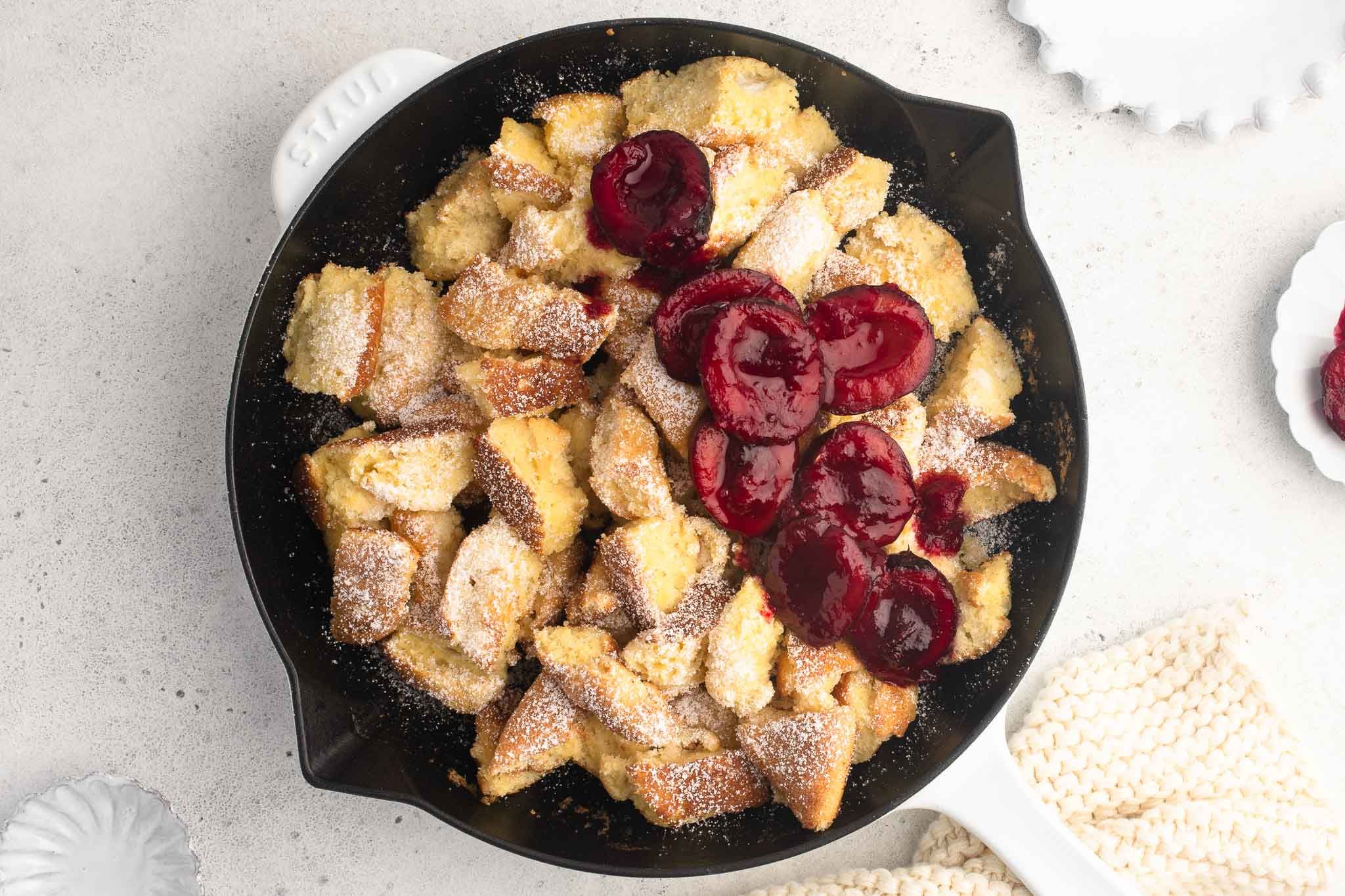Ever wondered what makes Switzerland pancakes so uniquely delicious and sought-after?
Finding the perfect pancake recipe can often feel like a culinary quest filled with trials and errors.
Switzerland pancakes are renowned for their similarity to French crepes but are distinctively larger, thicker, and can be customised with a variety of fillings and garnishes.
In this blog post, we’ll dive into the origins of famous variants like Kaiserschmarrn, explore step-by-step guides to making these delightful pancakes, and uncover the best toppings and techniques to enhance your pancake experience.
The Origins of Kaiserschmarrn: A Switzerland Pancake Classic
Kaiserschmarrn, often hailed as a quintessential Switzerland pancake, has a rich history tied closely to the royal kitchens of Austria. Originally named after Emperor Franz Josef I, this delightful dish is a symbol of culinary indulgence that has transcended geographical boundaries to become a favourite across various regions, including Switzerland.
The name ‘Kaiserschmarrn’ translates to ‘the emperor’s mess’, reflecting the scrambled, fluffy nature of the pancake which is typically torn into pieces during the cooking process. Its unique preparation and presentation, combined with the traditional dusting of powdered sugar and sides of fruit compotes, make Kaiserschmarrn a distinguished variant in the panorama of Swiss pancakes.
Lemon Tatsch: A Zesty Switzerland Pancake Variation

Lemon Tatsch, a zesty variation of the traditional Swiss Tatsch pancake, has gained popularity in the Graubünden region. This delightful recipe combines the tangy zest of lemon with a simple batter, creating a refreshing twist on the classic. Typically served warm with fruit preserves or applesauce, Lemon Tatsch offers a perfect balance of sweetness and citrus, making it a favourite for breakfast or as a dessert.
How to Make Switzerland Pancakes: A Step-by-Step Guide
Making Switzerland pancakes involves a delightful blend of simplicity and creativity. The process begins with preparing a smooth batter, which is the foundation for these delicious pancakes. The key to a perfect batter is ensuring all ingredients are well-incorporated, allowing the mixture to rest, which enhances the texture of the pancakes.
Cooking Switzerland pancakes requires a non-stick pan to ensure they cook evenly and achieve a golden brown appearance. The pancakes should be cooked on medium heat, allowing the batter to spread evenly and form light bubbles before flipping. This ensures a tender interior and a slightly crisp edge, which is characteristic of a well-made Switzerland pancake.
Once cooked, these pancakes can be served warm with a variety of toppings. Traditional choices include powdered sugar, fruit preserves, or simple maple syrup. The versatility of Switzerland pancakes makes them a delightful treat for any meal, whether it’s a hearty breakfast, a sweet dessert, or a unique dinner option.
Essential Ingredients for Perfect Switzerland Pancakes
The essential ingredients for perfect Switzerland pancakes include all-purpose flour, eggs, milk, and a pinch of salt. These ingredients form the basis of the batter, providing structure, richness, and flavour. It’s important to use fresh ingredients to ensure the best taste and texture in the pancakes.
Additionally, to enhance the flavour, you can add a teaspoon of vanilla extract or the zest of a lemon for a subtle citrus note. These ingredients are not only fundamental for the batter but also allow for variations in flavour, making each pancake experience unique and delightful.
Mastering Ratios for the Perfect Switzerland Pancake Mix
Mastering the ratios of ingredients is crucial for the perfect Switzerland pancake mix. A basic guideline is to use 1 cup of flour, 2 eggs, and 1 cup of milk. This ratio ensures the batter has the right consistency—not too thick and not too runny—which is key for spreading the batter evenly on the pan.
The consistency of the batter affects the texture of the pancakes; it should be smooth and slightly thick to hold on the pan without running too thin. Adjusting the amount of milk can help achieve the desired thickness. A well-balanced batter leads to light, fluffy pancakes that are moist on the inside and crispy on the edges.
Creative Add-Ins to Elevate Your Switzerland Pancakes

To elevate your Switzerland pancakes, consider adding creative ingredients into the batter. Choices like fresh blueberries, sliced bananas, or chocolate chips can add exciting flavours and textures. These add-ins should be folded into the batter gently to maintain the airiness of the pancakes.
For those who enjoy a richer flavour, swirls of cinnamon or dollops of Nutella can be added before cooking each pancake. These ingredients not only enhance the taste but also make the pancakes visually appealing and irresistible, perfect for a special brunch or a comforting meal.
Traditional Cooking Techniques for Switzerland Pancakes
Traditional cooking methods play a pivotal role in achieving the perfect texture and flavour of Switzerland pancakes. The process typically starts with frying the batter in a non-stick pan, which is crucial for getting that golden, crispy edge while keeping the inside soft and tender. The key is to maintain a consistent medium heat, allowing the pancake to cook evenly without burning.
Flipping the pancake is an art in itself, requiring timing and skill to ensure it doesn’t break. The pancake should be allowed to cook until the edges start to lift slightly and the bottom is golden brown. A quick, confident flick of the wrist helps turn the pancake smoothly, allowing the other side to cook to perfection, achieving the desired fluffy texture.
Whipping Eggs for Fluffy Switzerland Pancakes
For light and fluffy Switzerland pancakes, whipping the eggs correctly is essential. Start by separating the yolks from the whites. Beat the whites until stiff peaks form, then gently fold them back into the batter. This technique introduces air into the mix, making the pancakes delightfully airy.
Can You Bake Switzerland Pancakes? Exploring Alternatives
Baking Switzerland pancakes offers a delightful twist to the traditional frying method. To bake, pour the batter into a pre-heated, greased oven-safe dish and place it in an oven set at 190°C. This method allows the pancake to puff up evenly, creating a uniformly cooked texture throughout.
While baking might alter the classic texture slightly, it’s a great alternative for those seeking a less hands-on approach or making larger quantities. Serve the baked pancake with a sprinkle of powdered sugar and your choice of syrup or fresh fruits, turning it into a delicious, hassle-free treat.
Topping Ideas for Delicious Switzerland Pancakes

Switzerland pancakes offer a versatile canvas for a range of delightful toppings that can transform them from simple to spectacular. Whether you prefer the sweetness of syrups or the freshness of fruits, there’s a topping to suit every palate. Common choices include maple syrup for a classic touch, or a sprinkle of powdered sugar for those who enjoy a lighter sweetness.
For a more decadent treat, consider spreading Nutella or dolloping whipped cream atop your pancakes. Fruit lovers can top their pancakes with fresh strawberries, blueberries, or stewed apples, which add a refreshing contrast to the rich pancake base. Toasted nuts such as almonds or pecans provide a crunchy texture that complements the softness of the pancakes, making each bite a delightful experience.
Serving Sizes: How Many Switzerland Pancakes to Prepare
When planning to serve Switzerland pancakes, it’s important to consider the number of guests and their appetite. A general guideline is to prepare two to three pancakes per person. However, if you’re serving them as part of a larger brunch spread with other dishes, you might reduce the number to one or two pancakes per person to accommodate the variety of foods.
Pro Tips for Perfecting Your Switzerland Pancake Recipe
Achieving the perfect Switzerland pancake takes practice, but a few pro tips can help elevate your pancake game. Ensure your batter is smooth and free of lumps by thoroughly mixing the ingredients or using a blender. Letting the batter rest for at least 30 minutes before cooking can also improve the texture of the pancakes, making them tender and fluffy.
When it comes to cooking, use a non-stick pan and a moderate amount of oil or butter to prevent sticking and achieve an even golden colour. Flipping the pancake at the right time—when the edges look set and bubbles form on the surface—is key to keeping them intact and well-cooked. If you make a large batch, keep the cooked pancakes warm in an oven set at a low temperature while you finish cooking the rest.
Discover Switzerland Pancakes with INDULGE‘s Culinary Tours
INDULGE offers a unique culinary tour that dives deep into the heart of Zurich, providing an exceptional opportunity to explore the local flavours and techniques used in making Switzerland pancakes. Through guided tours led by expert chefs and local food artisans, participants get a hands-on experience in authentic Swiss pancake preparation, learning the subtle nuances that make these pancakes a national treasure.
The tours not only educate but also tantalise the taste buds. Key highlights include:
- Sampling various Switzerland pancakes from traditional recipes.
- Learning about the ingredients and methods that distinguish Zurich’s pancake styles.
This immersive approach ensures that participants leave with a richer understanding and appreciation of Swiss culinary arts, making their experience in Zurich truly unforgettable.
Frequently Asked Questions
Do they have pancakes in Switzerland?
Yes, Switzerland is known for its unique and delightful variations of pancakes, such as the Kaiserschmarrn and Lemon Tatsch. These pancakes are larger, thicker, and can be customised with a range of fillings and garnishes.
What is Kaiserschmarrn made of?
Kaiserschmarrn is made from a fluffy pancake batter that is typically torn into pieces during the cooking process. It is traditionally served dusted with powdered sugar and accompanied by fruit compotes.








